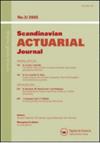局部偏置调整,持续时间加权概率,以及关税单元的自动构建
IF 1.4
3区 经济学
Q3 MATHEMATICS, INTERDISCIPLINARY APPLICATIONS
引用次数: 6
摘要
我们研究了非寿险定价,并给出了一个基于任何初始建议的预测器构建风险保费的无分布局部无偏预测器的一般过程。所得到的预测器是分段常数,对应于协变量空间的一个分区,并通过构造自动校准。两个关键问题是协变量空间的适当划分和处理随机变化的持续时间,承认可能提前终止合同。本文的一个基本思想是从初始预测器中划分预测,作为副产品,它定义了协变量空间的划分。详细讨论了创建分区的两种不同方法,分别使用(i)持续时间加权等概率分组和(ii)通过持续时间加权回归树分组。给定一个分区过程,要使用的分区大小是通过交叉验证获得的。通过这种方式,我们获得了一个自动数据驱动的关税程序,其中关税单元的数量对应于分区的大小。我们在模拟和真实保险数据的基础上说明了这一过程,使用简单的glm和gbm作为初始预测因子。结果表明,与初始预测器相比,所得关税具有相当少的关税单元,同时保持或提高了预测性能。本文章由计算机程序翻译,如有差异,请以英文原文为准。
Local bias adjustment, duration-weighted probabilities, and automatic construction of tariff cells
We study non-life insurance pricing and present a general procedure for constructing a distribution-free locally unbiased predictor of the risk premium based on any initially suggested predictor. The resulting predictor is piecewise constant, corresponding to a partition of the covariate space, and by construction auto-calibrated. Two key issues are the appropriate partitioning of the covariate space and the handling of randomly varying durations, acknowledging possible early termination of contracts. A basic idea in the present paper is to partition the predictions from the initial predictor, which as a by-product defines a partition of the covariate space. Two different approaches to create partitions are discussed in detail using (i) duration-weighted equal-probability binning, and (ii) binning by duration-weighted regression trees. Given a partitioning procedure, the size of the partition to be used is obtained using cross-validation. In this way we obtain an automatic data-driven tariffication procedure, where the number of tariff cells corresponds to the size of the partition. We illustrate the procedure based on both simulated and real insurance data, using both simple GLMs and GBMs as initial predictors. The resulting tariffs are shown to have a rather small number of tariff cells while maintaining or improving the predictive performance compared to the initial predictors.
求助全文
通过发布文献求助,成功后即可免费获取论文全文。
去求助
来源期刊

Scandinavian Actuarial Journal
MATHEMATICS, INTERDISCIPLINARY APPLICATIONS-STATISTICS & PROBABILITY
CiteScore
3.30
自引率
11.10%
发文量
38
审稿时长
>12 weeks
期刊介绍:
Scandinavian Actuarial Journal is a journal for actuarial sciences that deals, in theory and application, with mathematical methods for insurance and related matters.
The bounds of actuarial mathematics are determined by the area of application rather than by uniformity of methods and techniques. Therefore, a paper of interest to Scandinavian Actuarial Journal may have its theoretical basis in probability theory, statistics, operations research, numerical analysis, computer science, demography, mathematical economics, or any other area of applied mathematics; the main criterion is that the paper should be of specific relevance to actuarial applications.
 求助内容:
求助内容: 应助结果提醒方式:
应助结果提醒方式:


